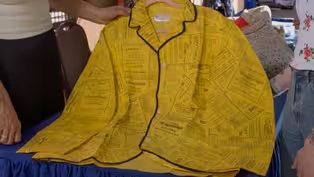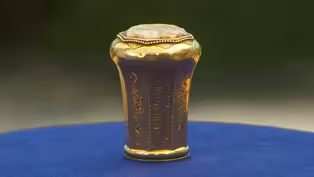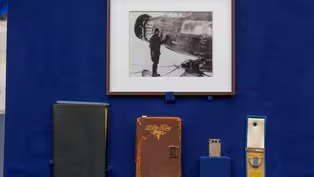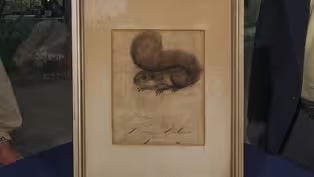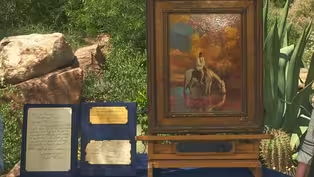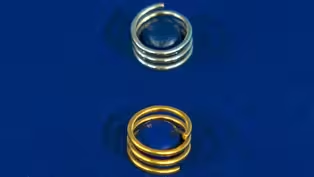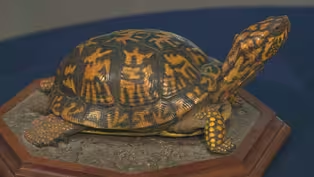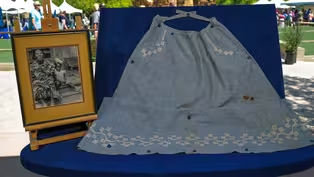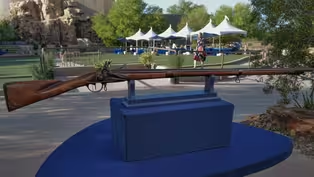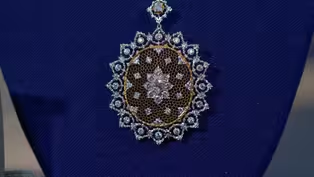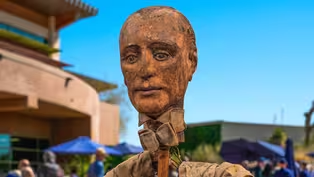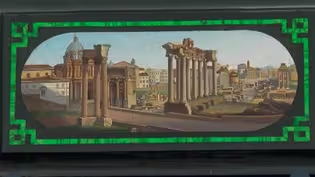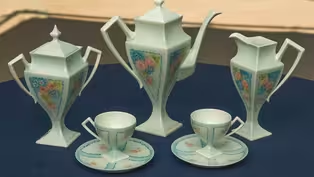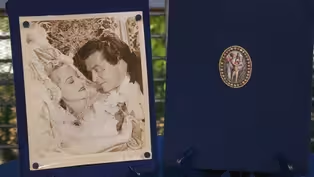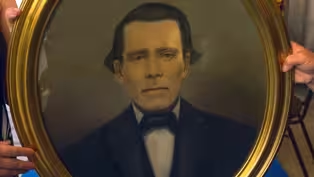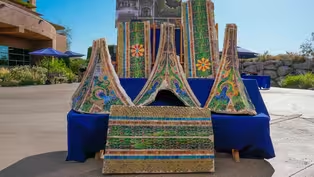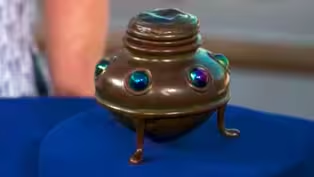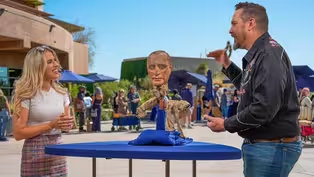
Appraisal: Paul Horiuchi Oil Painting & Collage
Clip: Season 29 Episode 5 | 3m 58sVideo has Closed Captions
Appraisal: Paul Horiuchi Oil Painting & Collage
Check out Graydon Sikes' appraisal of a Paul Horiuchi oil painting & collage in Springs Preserve, Hour 2.
Problems playing video? | Closed Captioning Feedback
Problems playing video? | Closed Captioning Feedback
Funding for ANTIQUES ROADSHOW is provided by Ancestry and American Cruise Lines. Additional funding is provided by public television viewers.

Appraisal: Paul Horiuchi Oil Painting & Collage
Clip: Season 29 Episode 5 | 3m 58sVideo has Closed Captions
Check out Graydon Sikes' appraisal of a Paul Horiuchi oil painting & collage in Springs Preserve, Hour 2.
Problems playing video? | Closed Captioning Feedback
How to Watch Antiques Roadshow
Antiques Roadshow is available to stream on pbs.org and the free PBS App, available on iPhone, Apple TV, Android TV, Android smartphones, Amazon Fire TV, Amazon Fire Tablet, Roku, Samsung Smart TV, and Vizio.
Buy Now

ANTIQUES ROADSHOW 2025 Tour!
Enter now for a chance to win free tickets to ANTIQUES ROADSHOW's 2025 Tour! Plus, see which cities we're headed to!Providing Support for PBS.org
Learn Moreabout PBS online sponsorshipGUEST: My father was in the relocation camps in Hunt, Idaho, called Minidoka during World War II... APPRAISER: Okay.
GUEST: ...during the Japanese relocation with his family.
My great-uncle Paul, who later became a, uh, relatively famous Northwest artist, came and visited the camps and did a painting of my father and his little sister.
APPRAISER: So your father was how old when he was in the camp in Idaho?
GUEST: 14-- they went into the relocation camp in late '42.
APPRAISER: Did he ever tell you any anecdotes about his experience?
GUEST: Well, you know, one thing is that they were only allowed to pack one bag.
My dad packed his bag full of spitballs.
(both laughing) 'Cause he thought he was the best spitball maker in Seattle, and he wanted to bring those spitballs to the camp.
APPRAISER: Wow.
GUEST: But, uh, I think it was a really mixed experience.
I mean, he was a Boy Scout and he followed the war and he knew all the old songs and he was a patriotic American.
He wanted the Americans to win, and later in life, he admitted, you know, it was hard for him.
He married a daughter of a four-star admiral.
He wound up joining the Central Intelligence Agency.
APPRAISER: (chuckling): Okay.
GUEST: And traveled all over the world with the U.S. government.
APPRAISER: And both of these are, are by the same artist, Paul Horiuchi.
GUEST: Exactly.
APPRAISER: So the one here, I'm seeing an oil on canvas.
So that's when he would have visited this camp.
GUEST: Okay.
Yeah, he wasn't interned because he wasn't in the, on the West Coast.
APPRAISER: You said that you met Horiuchi.
GUEST: I met him at least twice, probably more.
The two I remember is, as a small child, let's say five or six years old, going to his studio in Seattle.
It's a kid memory, so I just remember these big, beautiful things, these abstract things.
It seemed like the coolest place on Earth.
(both laugh) And he was the coolest guy on Earth.
APPRAISER: Paul Horiuchi, he lived a remarkable life.
GUEST: He did.
APPRAISER: Horiuchi was born in 1906 in Japan.
GUEST: Mm-hmm.
APPRAISER: His father left for the States when he was just a few days old.
And then he later joined them in Rock Springs, Wyoming...
GUEST: Ah.
APPRAISER: ...where they worked for Union Pacific Railroad.
GUEST: See, I didn't even know that.
APPRAISER: His father, uh, ended up passing away at a relatively young age.
GUEST: Uh-huh.
APPRAISER: And Horiuchi, you know, he, his life, his early life was filled with a great deal of hardship.
GUEST: Yes.
APPRAISER: He worked for the railroad, making ends meet, and really only started to come into his own as an artist in the 1930s.
GUEST: Right.
APPRAISER: Where he had a few group shows.
When World War II hit, of course, it was a difficult time.
GUEST: Yeah.
APPRAISER: He lost his job at the railroad, ended up taking a car repair job, I think...
GUEST: Yes.
APPRAISER: ...in the...
GUEST: I remember that.
APPRAISER: ...in the, toward the end of the war.
GUEST: Right.
APPRAISER: And, you know, his work was really on pause at that point.
He was nearly 40 years old, and he, he was really just trying to raise his family and keep employment.
GUEST: Mm-hmm.
APPRAISER: He had a solo show at the Seattle Art Museum in 1958.
There are anecdotes of his shows selling out prior to the opening.
GUEST: Wow.
APPRAISER: He was best known for his collage work, which is the example closest to you.
It's a combination of gouache, like, a heavier watercolor, and then little bits of paper that are applied in those posts.
And I know there's an inscription to your family from when it was done...
GUEST: Yeah.
APPRAISER: ...in the 1970s.
GUEST: Right.
APPRAISER: His most famous work is a large mural at the Seattle amphitheater.
GUEST: Yeah, Seattle Center.
APPRAISER: Um, and it's still there.
GUEST: Right by the, uh, tower, yes.
APPRAISER: The example here, when he visited Idaho, is not what he's known for.
GUEST: Right.
APPRAISER: It's an early work, and as a result, doesn't have a great deal of value.
Certainly sentimental value to your family.
GUEST: Yeah.
(laughs) Yeah.
APPRAISER: I would put an auction value at $500 to $700.
GUEST: Wow.
APPRAISER: The good news about the collage is, it is exactly in that mature, prime period of Horiuchi's work, and it is today the most desirable style.
If I were to place an auction estimate on it, I would estimate it in the range of $6,000 to $8,000.
GUEST: Oh.
Wow.
Wow.
APPRAISER: It's beautiful.
GUEST: I think so, too.
APPRAISER: It's a really nice example.
GUEST: Thank you-- thank you.
(chuckling)
Appraisal: Paper Men's Jacket, ca. 1965
Video has Closed Captions
Clip: S29 Ep5 | 51s | Appraisal: Paper Men's Jacket, ca. 1965 (51s)
Appraisal: 1861 Presentation Gold Letter Seal
Video has Closed Captions
Clip: S29 Ep5 | 1m 55s | Appraisal: 1861 Presentation Gold Letter Seal (1m 55s)
Appraisal: 1928 - 1930 R.E. Byrd Antarctic Expedition Group
Video has Closed Captions
Clip: S29 Ep5 | 3m 17s | Appraisal: 1928 - 1930 R.E. Byrd Antarctic Expedition Group (3m 17s)
Appraisal: 1933 Barney Nelson Crayon Drawing
Video has Closed Captions
Clip: S29 Ep5 | 1m 53s | Appraisal: 1933 Barney Nelson Crayon Drawing (1m 53s)
Appraisal: Bert Phillips Oil Painting, ca. 1935
Video has Closed Captions
Clip: S29 Ep5 | 2m 43s | Appraisal: Bert Phillips Oil Painting, ca. 1935 (2m 43s)
Appraisal: Dinh Van-designed Cartier Gold Ring, ca. 1955
Video has Closed Captions
Clip: S29 Ep5 | 2m 6s | Appraisal: Dinh Van-designed Cartier Gold Ring, ca. 1955 (2m 6s)
Appraisal: Doug Eppes Eastern Box Turtle Carving, ca. 1975
Video has Closed Captions
Clip: S29 Ep5 | 2m 34s | Appraisal: Doug Eppes Eastern Box Turtle Carving, ca. 1975 (2m 34s)
Appraisal: Formerly Enslaved Woman's Apron, ca. 1900
Video has Closed Captions
Clip: S29 Ep5 | 4m 15s | Appraisal: Formerly Enslaved Woman's Apron, ca. 1900 (4m 15s)
Appraisal: French Model 1763/66 Musket, ca. 1770
Video has Closed Captions
Clip: S29 Ep5 | 3m 19s | Appraisal: French Model 1763/66 Musket, ca. 1770 (3m 19s)
Appraisal: Gianmaria Buccellati Diamond & Gold Necklace, ca. 1972
Video has Closed Captions
Clip: S29 Ep5 | 3m 1s | Appraisal: Gianmaria Buccellati Diamond & Gold Necklace, ca. 1972 (3m 1s)
Appraisal: Harry Kellar Illusion Head, ca. 1900
Video has Closed Captions
Clip: S29 Ep5 | 3m 53s | Appraisal: Harry Kellar Illusion Head, ca. 1900 (3m 53s)
Appraisal: Italian Micromosaic, ca. 1870
Video has Closed Captions
Clip: S29 Ep5 | 2m 24s | Appraisal: Italian Micromosaic, ca. 1870 (2m 24s)
Appraisal: Limoges China-painted Coffee Set, ca. 1925
Video has Closed Captions
Clip: S29 Ep5 | 2m 15s | Appraisal: Limoges China-painted Coffee Set, ca. 1925 (2m 15s)
Appraisal: Paulette Goddard-worn Joseff of Hollywood Brooch
Video has Closed Captions
Clip: S29 Ep5 | 2m 14s | Appraisal: Paulette Goddard-worn Joseff of Hollywood Brooch (2m 14s)
Appraisal: Sun Enlargement Photo & Bubble Glass Frame, ca. 1900
Video has Closed Captions
Clip: S29 Ep5 | 1m 3s | Appraisal: Sun Enlargement Photo & Bubble Glass Frame, ca. 1900 (1m 3s)
Appraisal: Tiffany Glass Mosaics, ca. 1915
Video has Closed Captions
Clip: S29 Ep5 | 2m 33s | Appraisal: Tiffany Glass Mosaics, ca. 1915 (2m 33s)
Appraisal: Tiffany Studios Bronze & Glass Inkstand, ca. 1903
Video has Closed Captions
Clip: S29 Ep5 | 1m 48s | Appraisal: Tiffany Studios Bronze & Glass Inkstand, ca. 1903 (1m 48s)
Preview: Springs Preserve, Hour 2
Video has Closed Captions
Preview: S29 Ep5 | 30s | Preview: Springs Preserve, Hour 2 (30s)
Providing Support for PBS.org
Learn Moreabout PBS online sponsorshipSupport for PBS provided by:
Funding for ANTIQUES ROADSHOW is provided by Ancestry and American Cruise Lines. Additional funding is provided by public television viewers.


